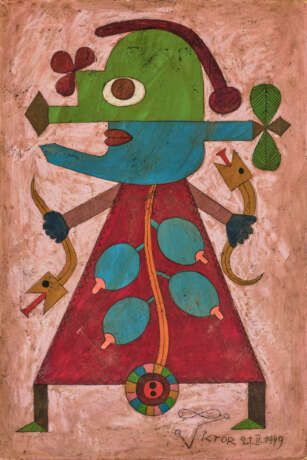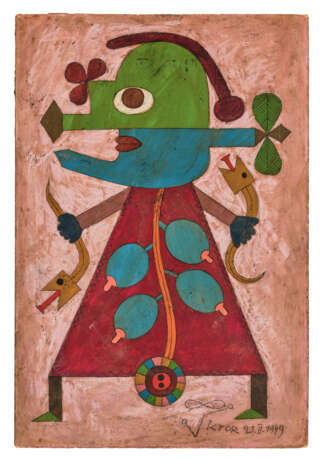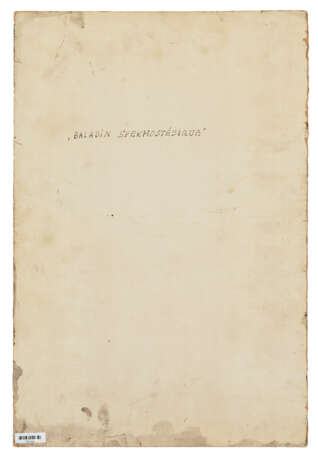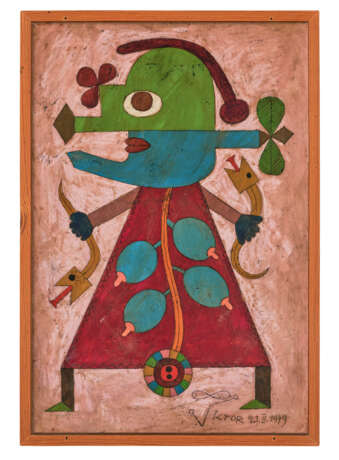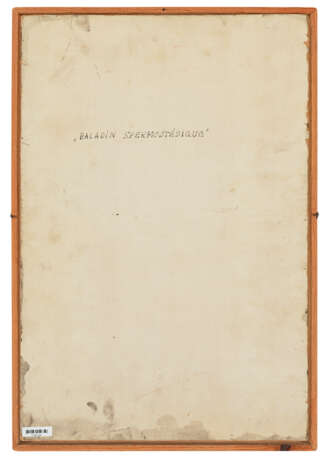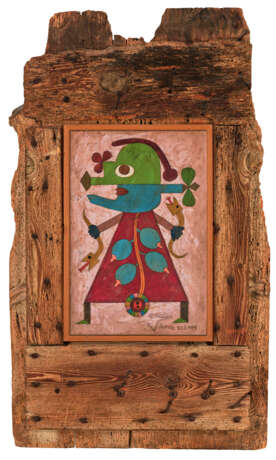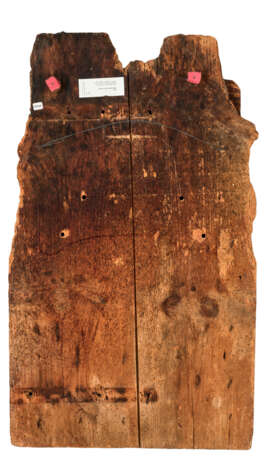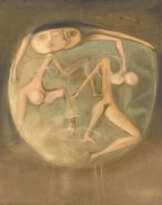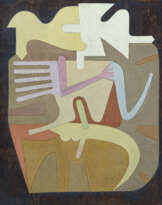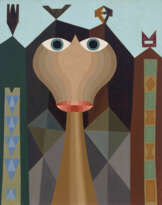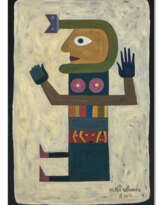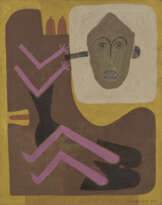ID 1302144
Lot 43 | Victor Brauner (1903-1966)
Estimate value
€ 100 000 – 150 000
Baladin Spermostésique
signé et daté ‘VIKTOR 21.II.1949’ (en bas à droite); inscrit '"BALADIN SPERMOSTÉSIQUE"' (au revers)
huile, cire à l'encaustique et plume et encre sur carton
46 x 31.1 cm.
Peint le 21 février 1949
signed and dated ‘VIKTOR 21.II.1949’ (lower right); inscribed '"BALADIN SPERMOSTÉSIQUE"' (on the reverse)
oil, encaustic wax and pen and ink on board
18 1/8 x 12 ¼ in.
Painted on 21 February 1949
Provenance
Joë Bousquet, Paris.
(probablement) Collection Castelnau, Paris.
Marcel Puech, Montpellier.
Robert Lagarde, Montpellier (acquis auprès de celui-ci probablement vers 1962).
Acquis auprès de celui-ci par l'intermédiaire de Pops Gaibrois, Toulouse, en mai 1975.
Literature
G. Bonnefoi, Les Années fertiles, 1940-1960, Paris, 1988, p. 196 (illustré en couleurs; titré 'Baladin spermesthésique').
D. Semin, Victor Brauner, Paris, 1990, p. 311 (illustré en couleurs, p. 197; titré 'Baladin spermesthésique').
P. Cabanne, La Chambre de Joe Bousquet, Enquête et écrits sur une collection, Marseille, 2005, p. 197 (illustré en couleurs; titré 'Baladin spermesthétique').
Exhibited
Tanlay, Centre d’Art Contemporain, Château de Tanlay, Victor Brauner, Arts primitifs, juin-septembre 1987, p. 46, no. 38 (illustré, p. 13; titré 'Baladin spermesthésique').
Saint-Cirq-Lapopie, Château de Saint-Cirq-Lapopie, Victor Brauner, juillet-septembre 2001.
Lille, Musée de l’Hospice Comtesse, Hypnos, Images et inconscients en Europe (1900-1949), mars-juillet 2009, p. 312 (illustré en couleurs, fig. 205; titré 'Balladin spermesthésique').
Paris, Galerie Malingue, Victor Brauner, octobre-décembre 2011, p. 58 ((illustré en couleurs, p. 59; titré 'Fantassin spermésthésique').
Further Details
La décennie 1938-1948 est une période d’expérimentation et d’affranchissement progressif pour Victor Brauner. Cherchant à fuir la France occupée, il rejoint Marseille en 1941, comme plusieurs membres du groupe des surréalistes espérant obtenir un visa pour les États-Unis par l’intermédiaire de Varian Fry, dirigeant du Comité Américain de Secours aux Intellectuels. Lorsque sa demande est rejetée, Brauner est contraint de se réfugier aux Celliers de Rousset dans les Hautes-Alpes. Il débute alors en 1942, dans un contexte général de rationnement des matériaux, une série d’expériences autour d’objets du quotidien, de métal, de pierres et de cire d’abeille le conduisant à la découverte du dessin à la bougie. Cette simplification des moyens et cet attrait pour les matériaux pauvres sont pour Brauner le moyen de se rapprocher d’une essence primitive de l’art. Se réjouissant de cette découverte, il écrit à André Breton : « j’ai aussi trouvé un nouveau procédé, dessin à la bougie [...]. Ne trouvant plus de toile à peindre, ai employé de la cire d’abeille comme fond à mes tableaux qui porteront l’inscription : ce tableau craint la chaleur, à garder et à regarder dans l’ombre, la cire, lien très important dans toute la magie et la science talismano-pantaculaire » (Victor Brauner, Je suis le rêve, Je suis l’inspiration, cat. exp., Musée d’Art Moderne de la ville de Paris, Paris, 2020, p. 170). La découverte de cette nouvelle technique marque donc pour l’artiste un véritable renouvellement. Il dira d’ailleurs que : « tout ce que j’ai fait était dans l’ombre » (V. Brauner, ‘Projet de lettre à René Char’, 16 février 1945, dans C. Morando et S. Patry, éd., Victor Brauner, Écrits et correspondances, 1938-1948, Paris, 2005, p. 180.)
Exécuté en 1949, un an après son exclusion du groupe des surréalistes, le Baladin Spermostésique reprend les codes du dessin à la bougie mais, à l’inverse du procédé originel, est d’abord recouvert de couleurs et ensuite d’une couche de cire transparente finalement incisée. La cire devient une surface sur laquelle l’artiste peut graver un monde poétique rempli d’animaux symboliques et de figures totémiques. Ce renouvellement de technique reflète donc également sa fascination pour le spiritisme et l’art talismanique. Cet intérêt particulier pour les sciences occultes découle directement de son père qui l’initie depuis son enfance à des séances d’hypnose et, plus tard, de la lecture de l’ouvrage de Marques-Rivière, Amulettes, talismans et pantacles dans les traditions orientales et occidentales, publié pour la première fois en 1950.
Le Baladin Spermostésique est une célébration de l’hybridation recherchée par Brauner; une hybridation des formes faisant naître un bestiaire imaginaire et une hybridation des styles empruntés à la fois aux codex précolombiens, aux traditions populaires et à l’art brut. C’est un retour aux sources primitives, un désir de saisir l’être à son état d’origine.
Emblématique et représentatif de la présente collection, le Baladin Spermostésique a d’abord appartenu à Joë Bousquet, un écrivain et poète narbonnais ayant entretenu de longues relations épistolaires avec Paul Éluard, Max Ernst ou encore Simone Weil. Il entre ensuite dans les collections de Marcel Puech, antiquaire du sud de la France installé plus précisément à Montpellier puis à Avignon dans les années 1950. Ce dernier vend la présente œuvre à Robert Lagarde, lui-même peintre, graveur et illustrateur montpelliérain. Lors d’une promenade dans la garrigue montpelliéraine, une zone de terre acide et calcaire d’où jaillit une végétation broussailleuse, le volet en bois d’une bergerie lui apparait fortuitement. S’adaptant parfaitement à l’œuvre, et en conformité avec la prédilection de Brauner pour les matériaux modestes, Lagarde décide d’en faire un cadre. Après avoir attendu de nombreuses années avant que Lagarde ne décide à se séparer de l’œuvre, Paul Duchein parvint enfin à en faire l’acquisition en mai 1975, par l’intermédiaire de Pops Gaibrois, un galeriste originaire de Montmaur dont les liens avec Paul Duchein étaient étroits.
Between 1938 and 1948, Victor Brauner experienced a period of experimentation and gradual emancipation. Fleeing occupied France, he moved to Marseille in 1941, like some other members of the Surrealist group, hoping to obtain a U.S. visa through Varian Fry, leader of the Comité Américain de Secours aux Intellectuels (American Emergency Rescue Committee for Intellectuals). When his request was denied, Brauner sought refuge in Les Celliers de Rousset in the Hautes-Alpes. In 1942, amidst material rationing, he began a series of experiments using everyday objects, metal, stones, and beeswax, leading him to the discovery of candle drawing. This simplification of means and this attraction to humble materials represented for Brauner a way to connect with the primitive essence of art. In a letter to André Breton, he expressed joy at this discovery, stating, "I also found a new method, candle drawing... I used beeswax as a background for my paintings which will bear the inscription: this painting fears heat, to be kept and looked at it in the shade, wax being a crucial element in all magic and talismanic science" (Victor Brauner, Je suis le rêve, Je suis l’inspiration, exh. cat., Musée d’Art Moderne de la ville de Paris, 2020, p. 170). This discovery marked a significant renewal for the artist, who stated, "everything I did was in the shadows" (V. Brauner, 'Project of a letter to René Char,' 16 February 1945, in C. Morando and S. Patry, eds., Victor Brauner, Écrits et correspondances, 1938-1948, Paris, 2005, p. 180).
Painted in 1949, a year after his exclusion from the Surrealist group, Baladin Spermostésique revisits the techniques of candle drawing. Unlike the original process, it is first covered in colors, then with a layer of transparent wax, which is finally incised. The wax becomes a surface on which the artist can engrave a poetic world filled with symbolic animals and totemic figures. This technical renewal also reflects his fascination with spiritualism and talismanic art. This particular interest in occult sciences directly stems from his father, who introduced him to hypnosis sessions since childhood and later through the reading of the book by Marques-Rivière, Amulettes, talismans et pantacles dans les traditions orientales et occidentales, first published in 1950.
Baladin Spermostésique is a celebration of the hybridization sought by Brauner: a merging of forms creating an imaginary bestiary and a blending of styles from pre-Columbian codices, popular traditions, and art brut. It is a return to primitive sources, a desire to capture the being in its original state.
Emblematic and representative of the current collection, Baladin Spermostésique first belonged to Joë Bousquet, a writer and poet from Narbonne who maintained long epistolary relationships with Paul Éluard, Max Ernst, and Simone Weil. It later entered the collections of Marcel Puech, an antique dealer from southern France, based in Montpellier and later Avignon in the 1950s. Puech sold the piece to Robert Lagarde, a painter, engraver, and illustrator from Montpellier. During a walk in the garrigue near Montpellier, an area of acidic and calcareous soil from which brushy vegetation emerges, Lagarde fortuitously found a wooden shutter from a shepherd's hut. Perfectly complementing the artwork and in line with Brauner's preference for modest materials, Lagarde decided to use it as a frame. After waiting many years for Lagarde to decide to part with the work, Paul Duchein finally managed to acquire it in May 1975 through Pops Gaibrois, a gallery owner from Montmaur who had close ties with Paul Duchein.
| Artist: | Victor Brauner (1903 - 1966) |
|---|---|
| Auction house category: | Paintings, Watercolors, Drawings, Paintings |
| Artist: | Victor Brauner (1903 - 1966) |
|---|---|
| Auction house category: | Paintings, Watercolors, Drawings, Paintings |
| Address of auction |
CHRISTIE'S 8 King Street, St. James's SW1Y 6QT London United Kingdom | |
|---|---|---|
| Preview |
| |
| Phone | +44 (0)20 7839 9060 | |
| Buyer Premium | see on Website | |
| Conditions of purchase | Conditions of purchase |
